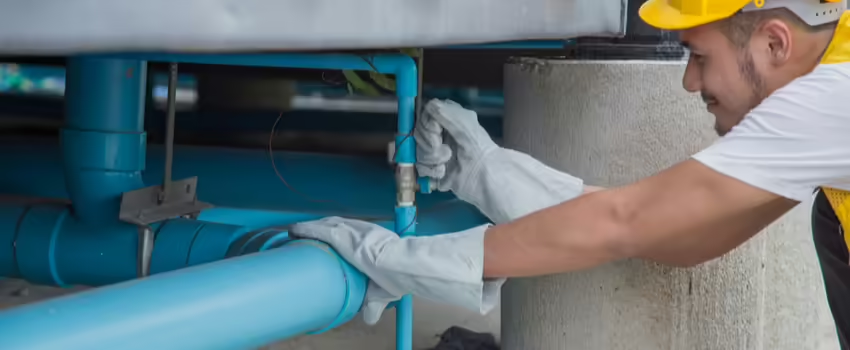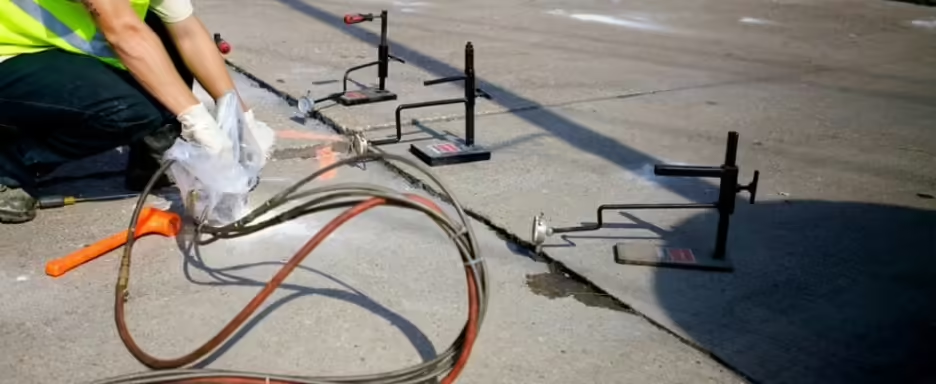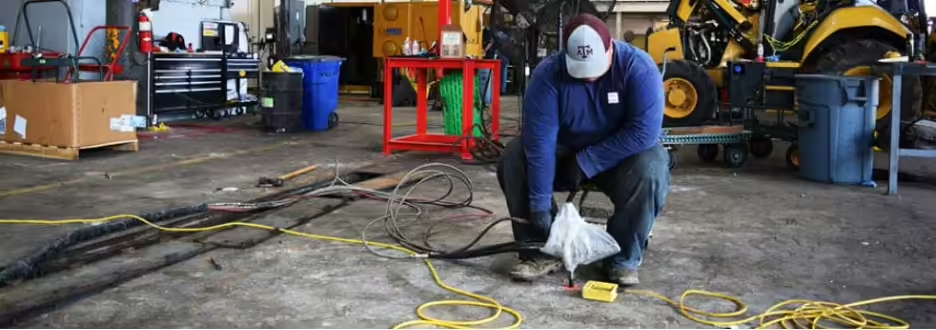At Leveled Concrete, our foundation repair experts have seen the damage that comes from skipping the basics.
Here’s a foundation maintenance guide to help you stay ahead of problems if you own a home, run a business, or manage properties in Texas.
Quick List: 10 Maintenance Tips for Your Home’s Foundation
- Don’t Ignore Cracks
- Move Water Away from Your Foundation
- Keep Soil Moisture Consistent
- Watch for Tree Roots
- Schedule Annual Plumbing Tests
- Make Sure Your Yard Slopes Right
- Maintain Stable Indoor Temps
- Install a Root Barrier
- Keep a Foundation Log
- Call a Pro
Foundation Maintenance Guide for Texas Property Owners
As a Texas property owner, it is important to stay on top of proper foundation maintenance in order to ensure your home or business remains structurally sound. Foundation preventative maintenance involves looking for signs of foundation issues, repairing any existing damage, and taking measures to protect against future structural foundation damage. In the list below, we will discuss some essential tips for how to properly maintain foundations.
1. Don’t Ignore Foundation Cracks
Cracks are often the first warning sign that something’s wrong. They might show up in drywall, bricks, tile, or at the base of your structure. Tiny hairline cracks in the walls may not seem urgent, but they can let in moisture or grow over time. Wider cracks or ones that change quickly may point to shifting soil or structural movement. If door frames pull away from the wall or floors slope, have the foundation checked.

What’s the difference between cosmetic and structural cracks? Cosmetic cracks are usually hairline and don’t change over time. Structural cracks are wider, deeper, or change shape. If cracks expand or are wider than 1/8 inch, call a foundation specialist.
Check out our Homeowner’s Foundation Inspection Checklist.
2. Redirect Water Away from Your Foundation
Standing water near your foundation weakens the soil and puts pressure on the structure. Make sure gutters are clear and that downspouts extend far enough to keep water away. Use splash blocks or extensions to push runoff several feet out. Consider French drains or surface drains if the yard tends to hold water during storms.
3. Maintain Consistent Moisture Levels Around Your Foundation
Foundation soil movement is a top cause of foundation problems. During dry seasons, the ground shrinks and pulls away. After heavy rain, it expands again. This back-and-forth stresses your foundation. Set up a timer for a soaker hose or sprinkler to keep moisture even. Don’t overwater-slow, steady watering near the perimeter works best.
Signs You’re Overwatering or Underwatering:
Overwatering can be as harmful as drought. Tips:
-
Pooling water near the edge? Too much.
-
Gaps between soil and slab? Too dry.
How often should I water around my foundation in summer? Water every few days during dry spells, especially in clay-heavy soil. Use a soaker hose about 18 inches from the slab, set to run slowly for 20-30 minutes in the early morning or late evening.
4. Keep Tree Roots Away from Your Foundation
Large trees with deep roots can pull moisture from under your foundation or physically disturb the soil. Keep trees at least 15 – 20 feet away. Smaller shrubs should also be planted with care. If large trees are already nearby, monitor the area for cracks or soil movement.
5. Conduct Annual Plumbing Tests
Hidden plumbing leaks under your slab or near pier and beam supports can go unnoticed for months. Leaking freshwater or drain lines can soften the soil, causing it to shift. Have a licensed plumber do a pressure test or camera inspection once a year, especially if your water bill changes or you hear running water when fixtures are off.
Consider scheduling plumbing tests during late spring or early summer. That way, any leaks or drainage issues are caught before hot, dry months put extra pressure on your foundation.

6. Grade the Land for Proper Drainage
Your yard should slope gently away from the house to prevent water from pooling near the base. Aim for at least a 5% slope for the first 5 – 10 feet. Fill low spots with soil and reseed grass where needed. Avoid placing heavy landscaping materials or mulch too close to the foundation.
Regrading small low spots is doable with basic yard tools and soil. But if the slope issue spans several sides of the home or affects drainage long-term, a landscape or drainage professional should take a look.
7. Maintain a Steady Temperature Year-Round
Texas homes go through wide temperature swings between seasons. If you turn off the AC or heat for long stretches, this can add stress to concrete slabs and interior walls. Keep your HVAC system running on a consistent schedule. This also helps regulate moisture levels inside the structure.
8. Add a Root Barrier
A physical root barrier helps stop tree roots from spreading toward your foundation. These barriers are often installed in a trench between trees and the structure, using materials like plastic panels or geotextile fabric. They work well as a long-term solution when removal of trees isn’t an option.
9. Keep A Foundation Log
Write down anything you notice: slab foundation cracks, shifting, repair visits, and weather events. Use your phone to take photos once or twice a year. This record helps professionals spot trends, and it’s useful if you ever need to file a warranty claim or sell the property.
10. Get A Professional Opinion
If you see something that doesn’t feel normal, have it checked. Foundation problems don’t go away on their own. The earlier you catch it, the easier and less costly repairs are.
Minor building foundation cracks can be monitored and logged. But if they spread, shift, or come with other signs like sticking doors or sloped floors, it’s time for an expert inspection. Small fixes cost less when caught early – full foundation repairs can get expensive fast.

Read now: Is Your House Settling or is it Something Worse?
Differences Between Slab and Pier & Beam Maintenance
Both slab and pier and beam foundations support structures, but they react differently to moisture, temperature, and soil changes. Concrete maintenance needs vary depending on the type you have.
Slab Foundations
- These are more vulnerable to soil movement since they rest directly on the ground. Cracks and shifting are common signs of trouble.
- Keep an eye on interior floors, door frames, and exterior bricks. Sudden movement could point to uneven support under the slab.
- Moisture control is especially important. Dry soil can cause sinking, while too much water may lead to lifting or cracking.
Pier and Beam Foundations
- These have crawl spaces, which makes them easier to inspect but more exposed to humidity.
- Watch for sagging floors, musty smells, or wood rot under the structure.
- Ventilation and proper drainage under the home are important. Check for standing water and monitor for pests or mold.
Knowing your foundation type helps you apply the right maintenance steps and spot serious foundation issues early.

Foundation Maintenance by Season
Foundation needs shift with the weather. Here’s what to keep an eye on throughout the year:
Spring
- Walk your property after heavy rains to check for pooling water.
- Inspect the base of your home for new cracks or signs of foundation movement.
- Clean out gutters and downspouts to prepare for storms.
Summer
- Use a sprinkler or soaker hose during dry spells to keep soil moisture steady.
- Check for soil pulling away from the foundation.
- Schedule plumbing tests before peak heat.
Fall
- Clear leaves and debris from gutters and proper drainage paths.
- Trim back tree limbs and shrubs near the structure.
- Check crawl spaces for humidity if you have a pier and beam foundation.
Winter
- Watch for drafts, door misalignment, or cracked foundation (these may signal shifting)
- Avoid large indoor temperature swings to reduce slab stress.
Keeping a seasonal checklist makes small tasks easier to manage and helps prevent foundation damage before it starts.
Contact Leveled Concrete For a Professional Consultation
Maintaining your foundation isn’t hard. These tips give you a place to start, especially in Houston and Southeast Texas where heat, rain, and soil movement create added pressure.
Leveled Concrete is an experienced and reliable foundation repair company that has been serving Texas property owners for decades. Our team of experts has extensive experience in conducting foundation repairs, and they can help you identify the right repair solution for your home or business. We offer various services to meet your needs, including concrete slab foundation repair, foam jacking with polyurethane, and more.
Contact Leveled Concrete today to learn more about our professional foam concrete lifting services.

